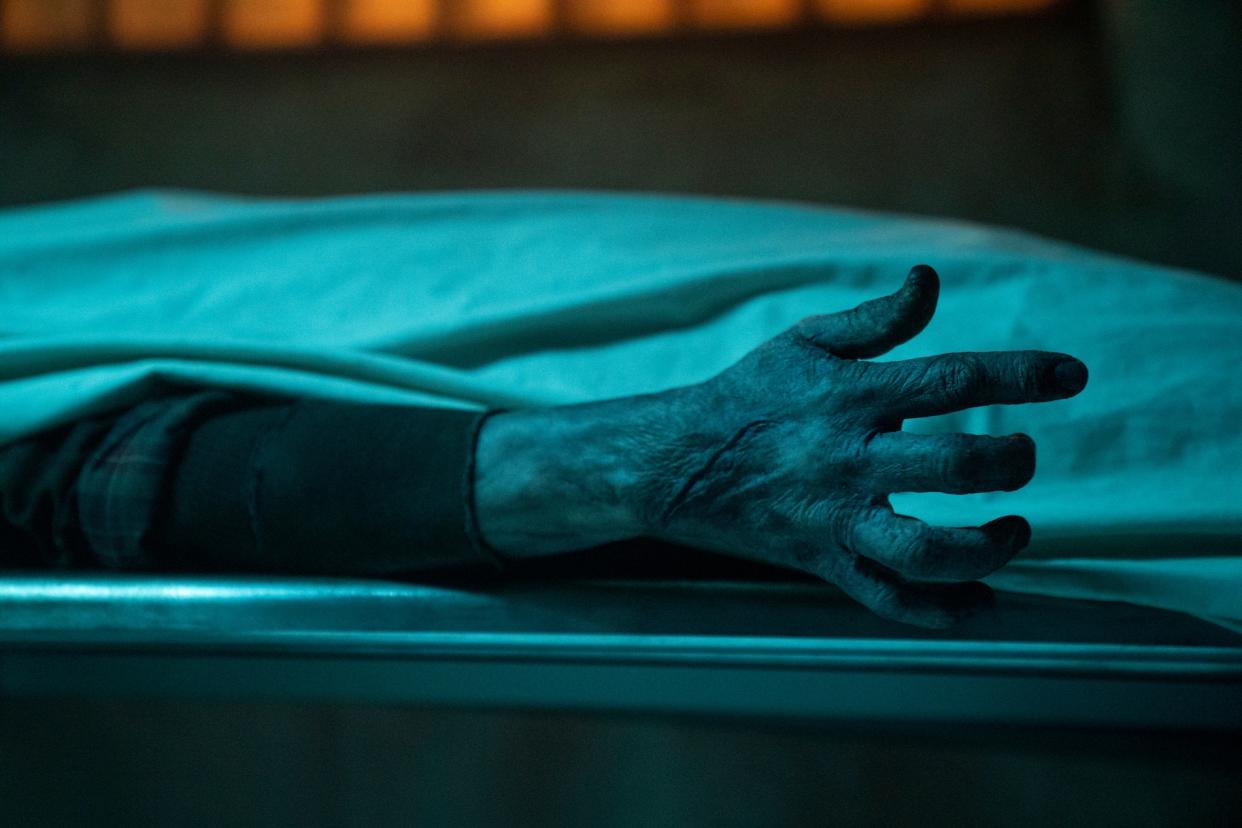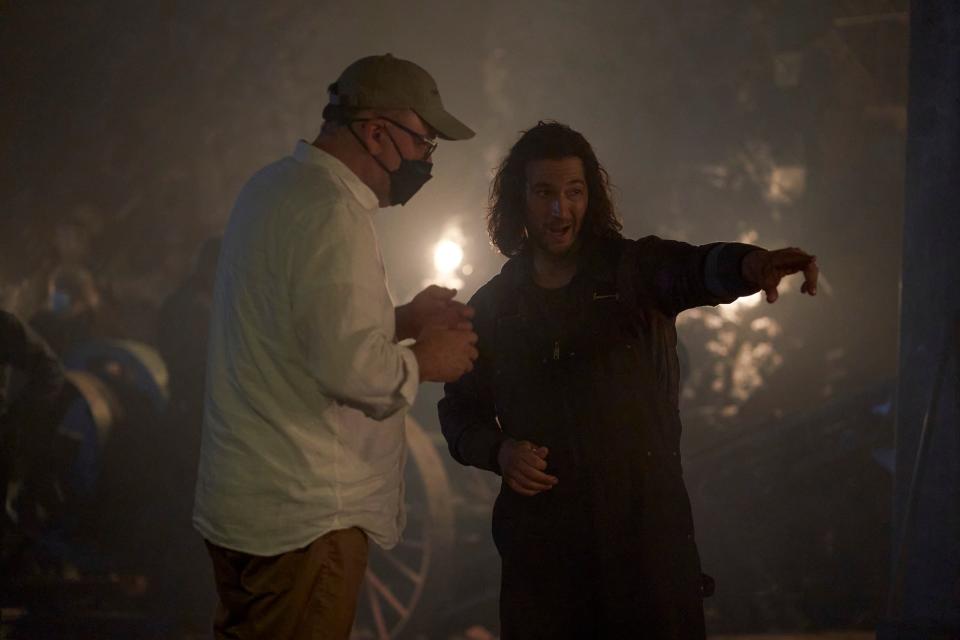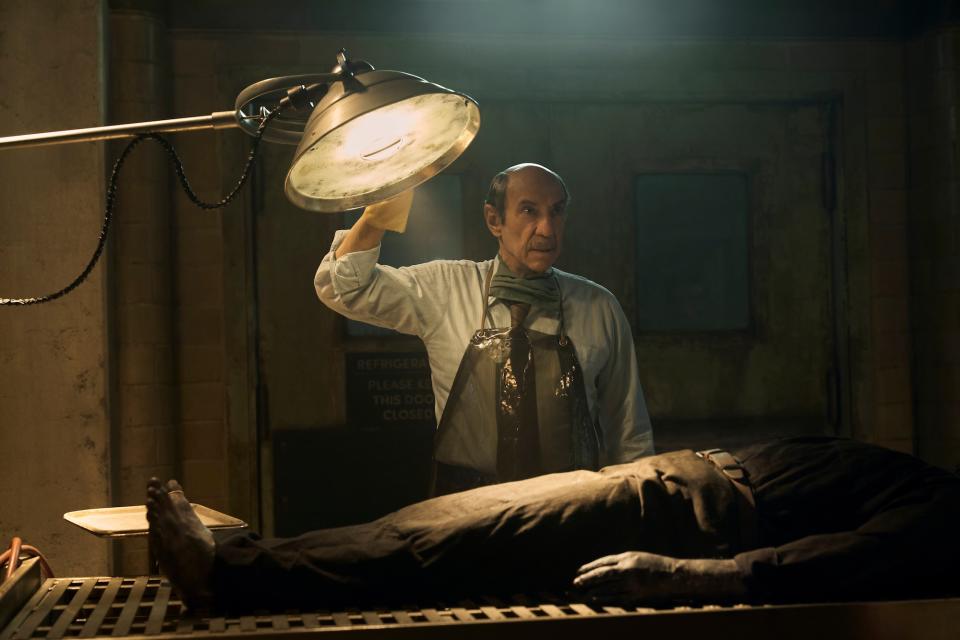Director David Prior’s ‘The Autopsy’ Is an Instant Horror Classic

- Oops!Something went wrong.Please try again later.
[Editor’s Note: The following interview contains spoilers for “Guillermo Del Toro’s Cabinet of Curiosities” Episode 3, “The Autopsy.”]
A little while ago, director David Prior got an unexpected gift. A package showed up in the mail. Inside was a tiny figurine of a bearded man.
More from IndieWire
'Girls5eva' Moves from Peacock to Netflix with Season 3 Order
'The Pale Blue Eye' Teaser: Christian Bale Joins Edgar Allan Poe in 1830s Serial Killer Mystery
“I got it in the mail before I even knew what it was. I thought, ‘Oh, that’s nice. A little souvenir. Did Guillermo whittle this himself?’” Prior said. “I assumed it was Dr. Winters when I got it.”
Dr. Winters is the main character in “The Autopsy,” the episode of the Netflix series “Guillermo Del Toro’s Cabinet of Curiosities” that Prior directed. In this version of Michael Shea’s short story, adapted with the help of screenwriter David S. Goyer, Winters is called on to help an investigation into what local police believe is a tragic mining explosion. By the time he gets a chance to examine the bodies pulled from the wreckage, Winters discovers that something about those deaths wasn’t exactly natural.
But as Prior discovered when he watched the completed episode, the small statue was of him, not his protagonist. In each of the “Cabinet of Curiosities” installments, Del Toro continues in the tradition of past anthology hosts with a short introduction. Each ends with him tipping his hat to the director of the episode audiences are about to see, with their figurine likeness front and center.
That kind of onscreen salute is far from the support that Prior’s debut feature, “The Empty Man,” got when it was released almost exactly two years before. A victim of studio merger jockeying, a theatrical distribution model in chaos, and a whole host of marketing bungles, “The Empty Man” took a groundswell of devoted fan support to gradually reach the audience it deserved.
“The Autopsy” doesn’t have quite the immense and global scope of that debut feature, but the same meticulous, precise spirit of Prior’s visual storytelling comes through. It’s a detective story of a different kind, with Winters (played by F. Murray Abraham) bringing a key emotional match to the jargon-heavy work of his profession. What this doctor finds is beyond the anatomical puzzle he expected.
And it’s another story that marries the technical craft of unsettling audiences (split fingernails! corpses in bags covered in insects!) with heady thematic ideas about what life is worth and how to spend it. From the mine explosion set piece to the an insert shot of whiskey splashing into a coffee mug, everything in “The Autopsy” serves a purpose. Prior spoke with IndieWire about the process of joining a horror playground in progress and adding another impressive tale to his own collection.
IndieWire: The opening transition between the spider web and the stars and the wall of the mine, that seems like an idea that would be simple enough in theory but required some specific execution.
David Prior: That was an idea that I cribbed from another script of mine that I haven’t made. I’ve been trying to get that idea of the reflective wall of wet anthracite coal. If you’ve ever been in a cave, when it’s wet, it does look a lot like you might be seeing into another dimension. That was a very, very tricky thing to do. I’m not entirely sure we nailed it. I think the idea’s there. I may try it again someday.
Guillermo actually came in and suggested the addition of the spiders. He was watching my dailies, and in one of the establishing shots of the river, we happen to see this spider web up in a tree. I thought, ‘I don’t know what this would be for, but I kind of like it. It feels like it might have a place somewhere.’ So I shot this close-up of a spider web and some focus racks to use as an establisher. It obviously fired off something in Guillermo’s mind. Moths was going to be the recurring thing and he suggested the spider. It just added another level of density to the transition.

Ken Woroner/Netflix
One of the things that stands out in this and “The Empty Man” is a real sense of spatial awareness, not only how the characters move through an area, but the camera too. I imagine it helps to be working with Anastas Michos again, to already have that shorthand.
Effective mood building and atmosphere and suspense can only really happen if you’re constantly being oriented to where everything is. I like the classical discipline of the axis and of making sure that people have shots that are wider than just close-ups, to feel the space that they’re in. And Tas is great. He’s a great DP and we get along really well. We occasionally come to blows, but only in a friendly, creative way. “Empty Man” was a really tough shoot in a lot of ways, and he not only survived it, but he thrived in it. So it was natural to bring him along. It’s just much easier when you don’t have that primate grooming behavior that you have to go through when you’re meeting somebody for the first time.
Were there any particular sequences in “The Autopsy” that the two of you knew would be a big challenge?
The stuff that kept me up at night was being in one location with one actor for that long. How do you keep it alive enough that you’re able to follow all of the intricacies of the plot? As the accretion of detail happens, as he’s building this case in his own mind, you don’t have another character for him to be bouncing off of. He doesn’t go outside for a smoke and think about it. So it was finding out ways to keep the repetitiveness of the autopsies from being unpleasantly repetitive. Some aspect of the repetition is important. But after a while, it is really involved.
We had some consultants, some pathologists come in and advise us on what the proper procedures would be. Training Murray on how to hold the knives and what the steps are when you’re first getting a body. One of the things I didn’t think about was the clothing. Just getting a corpse undressed takes more screen time that we have to spare here. It became a question of finding angles that could keep the thing alive, feeling like, the first autopsy, you were being given enough sense of how long this takes, what it’s like in this room with this object that I have to deal with. And then once we’d done it once, we could start breezing through it.
F. Murray Abraham’s performance is obviously great here, but getting that injection of Luke Roberts is really a jolt to everything. What were you looking for in his physicality and how did that match up with what you’d envisioned for his scenes?
Luke is a is a very highly tuned physical specimen. I felt like a corpse that’s been lying under a rock for a week probably shouldn’t have such rippling biceps. But he’s got fine motor control and a real command of what his body can do. I had the image in mind beforehand of Christian Bale in “The Machinist.” What you would lose from that and what Luke had to offer was the ability to do take after take after take of crawling on the ground, using his fingertips to pull himself forward. Hitting little tiny marks, staying within the plane of focus, and doing it while he was delivering a performance that was memorable and striking and everything that the show needed.
That moment where his mouth is talking upside-down is really unnerving. How much of that was motor control and how much was a little bit of trickery?
There was some trickery there. I liked the idea that it almost has a Señor Wences feeling when you’re looking at him upside down like that. But it just felt like it needed to be something off-putting, so that the visuals are in tune with what he’s talking about. I just liked looking at him upside down. When I had it framed like that, I thought it was just a more interesting way of hearing this language.
We did do tiny little things. There were a couple of times where I froze his eyes. Luke was really good at not blinking, but nobody’s perfect. You can’t not blink for some extended periods of time. And it just created a kind of weird, unnerving feel. There’s a throwaway double exposure in “The Exorcist” that always creeped the hell out of me. It’s a combination of Linda Blair and Eileen Dietz, who was the makeup stand-in/Pazuzu face. They did this really dirty split comp of those two faces together. Somewhere that was probably in the back of my mind that if we froze part of Luke’s face and let the other part keep talking, you would get some uncanny oddness to it.

Ken Woroner/Netflix
As far as the design of the actual creature itself, any time you throw tentacles in the mix, I feel like that that increases the degree of difficulty by an order of magnitude. What were conversations like about how it would look?
There were some pretty funny conversations, probably a little too blue to say out loud here. There’s nothing overly Giger-esque in it, but the things that make [H.R.] Giger so penetrating is not just the combination of the biological and the mechanical, but it’s the way that it has a fecund kind of sexuality to it. There are sex organs being tortured in strange ways that really gets under your skin. I wanted it to recall some elements of that.
We did several different rounds of designs with a really talented group of designers. The nice thing about the current day, when designers are working digitally, you can get some pretty elaborate mock ups and they look really photoreal and beautiful. In the old days, you’d be looking at little pencil sketches and throwing a dart at it, making a guess and hoping. But there was something about the one that we ended up with that seemed really exciting and interesting.
I told them about this idea of trypophobia, the fear that people have about little openings. Sometimes you’ll see hands with seed pods photoshopped into them and little worms poking out of them. We tried to work that design into the creature and also into Luke’s chest. There’s some places where you see these divots and indentations, almost like a strange remembrance of some alien biology that’s appearing in his flesh. And then, in the shot where the creature is being passed over to Murray, Guillermo wanted a little defecation coming out of the backs of those holes. I was like, “Only Guillermo would come up with that.”
This episode takes some dialogue directly from Michael Shea’s story, but the final message that Winters writes in blood on his chest (“PLAY TAPE BURN ME”) is a little different here. Given that’s one of the last images you leave the audience with, how did you go about phrasing and staging that?
When Guillermo offered this to me, it struck a bell. I’d read the story years and years ago. As soon as I got off the phone with him, I walked five feet over to my bookshelf and pulled my copy of “The Dark Descent” off the shelf and reread it. There are a lot of things in that story that are easy enough to say in prose, but you have to actually execute them visually. If he’s completely paralyzed, except for one hand, and that hand is tied down by surgical tubing, and he’s up on a table where’s he writing this, those tables aren’t big enough. There’s no negative space here to write anything and even if you did, blood is not viscous enough. It’s much too liquid to maintain those shapes. So, in puzzling that out, I was thinking that the message has to be short. He has to have a canvas somewhere that he can reach, and so his chest seems the natural thing. Except, of course, he can’t reach down below too far because if he could, he could stab the thing with the scalpel. So there’s all these things that you’re trying to deal with and hoping that if you just observe enough, the audience will trust you that you know that they’ll stop second-guessing you.
“The Autopsy” and “The Empty Man” are both stories of potential apocalypses filtered through one’s man’s experiences. There’s also ideas in both about control and mortality and bodily autonomy. How conscious were you of those kinds of overlaps?
The thing that’s a little different is I didn’t generate this project. I was a grateful invitee to the coolest party in town. And I didn’t think it would be appropriate to start kicking over the furniture and vomiting on the floor and turning it into my thing. I was there to serve the needs of the show that Guillermo had graciously invited me to. And so I didn’t spend much time trying to figure out how to fit it into my oeuvre. [Laughs]
There’s something Guillermo said to me on “Blade II” when we first met all those years ago. He looked at that movie as kind of a Catholic exercise in modesty. He wasn’t there to make a Guillermo Del Toro Movie. He was there to make a kick-ass comic book movie. On some level, it’s impossible to not put yourself into the things. It’s not that I don’t see the commonalities there. I just didn’t chase them down on purpose. The thing I liked about this story was the idea of somebody laying themselves down on the line to save mankind, right? He’s saving the entire human race but in an unsentimental way. It’s pretty hard to be sentimental when you’re gouging out your own eyes. The goodness of that, the triumph of the guy having to go through this unspeakably torturous death but for a much greater purpose: If I’m going to deal with that idea, I like that it was in a context like this where there’s nothing saccharine about it. But stories of the apocalypse seem to be out in the air right now. They just naturally come up. If this thing feels or reminds anybody of my other stuff, then I take it as a point of pride and happily include it in my catalog.
“The Autopsy” — part of “Guillermo Del Toro’s Cabinet of Curiosities” — is now available to stream on Netflix.
Best of IndieWire
From 'Reality Bites' to 'Fatal Attraction,' Keep Track of All the Upcoming Film-to-TV Adaptations
7 New Netflix Shows in October 2022 — and the Best Reasons to Watch
Sign up for Indiewire's Newsletter. For the latest news, follow us on Facebook, Twitter, and Instagram.

